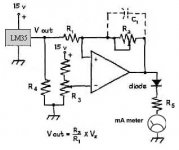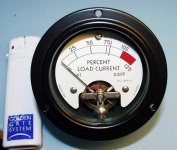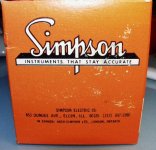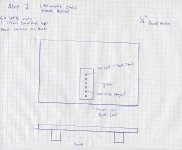I was thinking of putting some type of meter on the 3ch AX35 I’m building; just to improve the looks of the amp. So I got to thinking, what are the most useful things I could measure. After going over the list of the usual suspects, output power, input current draw, ac current draw, I finally decided that to me mosfet temperature would be the most useful thing to measure. It could help prevent a tragedy on a hot summer day and it could tell you when the amp is totally worm for best sonic results. Plus, I don’t have to put anything in the signal path or any shunts on the power rails.
As for the actual meter it’s self I have not yet decided if I should use a digital 7 segment display or an analog meter like the X amps. If I use the analog meter I will remove the plastic cover and replace the paper backing with my own layout. I will rout out a hole in the case and insert a glass plate in the whole and add some red LEDs on the sides to crate the right atmosphere.
As for the circuit it’s self, I’m not totally shore I can pull off building a circuit like this.
There are, as far as I know three main ways to sense temperature. One is with thermistors, the other is with snap switches, and the last is with semiconductors designed just for this task.
Thermistors are best for reliability and high temperature, because there basically just resistors they don’t really break. Unfortunately I can’t figure out how to calculate the resistants at a given temp. There also not very linear in terms of there change in resistants. You also can’t put that much power in them because they start to heat up and this gives you false readings. So there will have to be some amplification of the voltage that is derived from it. In the digi-key catalog I couldn’t really find a shape of thermistors that is really convenient for mounting next to or on one of the mosfets. I’m also looking into the thermistors used to monitor car engine temp, but there size shape and weight makes them really difficult to mount.
The Bi-metal snap switch is a device that is open or closed at a given temp them when they go over there limit temp they change state. The problem with these is that you would have to parallel up many devices in different temp points to sense a range of temperatures and at $7 to $10 that’s not cheap. This approach is probably not the most practical.
Solid state temperature sensors seem like a good way to go. I was blown over by the number of solid state temperature sensors my digi-key catalog has. The LM35 made by national semiconductor looks to be a good pick. Digi-key has it in TO-92, TO-46, SO-8 and TO-220 cases. They only cost between $2 and $8 and you only need one. They put out a very linear current based on change in temperature. In the technical papers it says that you can hook these up directly to a current meter. However 600uA meter are hard to find so some sort of amplification will probably be needed.
Here is a circuit I have drawn up but not tested that I think may work:
Levente Hajdu
As for the actual meter it’s self I have not yet decided if I should use a digital 7 segment display or an analog meter like the X amps. If I use the analog meter I will remove the plastic cover and replace the paper backing with my own layout. I will rout out a hole in the case and insert a glass plate in the whole and add some red LEDs on the sides to crate the right atmosphere.
As for the circuit it’s self, I’m not totally shore I can pull off building a circuit like this.
There are, as far as I know three main ways to sense temperature. One is with thermistors, the other is with snap switches, and the last is with semiconductors designed just for this task.
Thermistors are best for reliability and high temperature, because there basically just resistors they don’t really break. Unfortunately I can’t figure out how to calculate the resistants at a given temp. There also not very linear in terms of there change in resistants. You also can’t put that much power in them because they start to heat up and this gives you false readings. So there will have to be some amplification of the voltage that is derived from it. In the digi-key catalog I couldn’t really find a shape of thermistors that is really convenient for mounting next to or on one of the mosfets. I’m also looking into the thermistors used to monitor car engine temp, but there size shape and weight makes them really difficult to mount.
The Bi-metal snap switch is a device that is open or closed at a given temp them when they go over there limit temp they change state. The problem with these is that you would have to parallel up many devices in different temp points to sense a range of temperatures and at $7 to $10 that’s not cheap. This approach is probably not the most practical.
Solid state temperature sensors seem like a good way to go. I was blown over by the number of solid state temperature sensors my digi-key catalog has. The LM35 made by national semiconductor looks to be a good pick. Digi-key has it in TO-92, TO-46, SO-8 and TO-220 cases. They only cost between $2 and $8 and you only need one. They put out a very linear current based on change in temperature. In the technical papers it says that you can hook these up directly to a current meter. However 600uA meter are hard to find so some sort of amplification will probably be needed.
Here is a circuit I have drawn up but not tested that I think may work:
Levente Hajdu
Attachments
That is an interesting idea. Did you consider using analog meter? There are nice, round ones, used on barbecues. If you could somehow illuminate it with a blue light, it may look almost as good as a meter on Alephs. 😉
Why not use an LCD ? I made a temperaturemeter with a 2x16 LCD , Atmel 2313 , ADC8038 and 8 x LM35.
You could also use 4 x LM35 for tempratures and use the other 4 inputs to measure currents / voltages.
You could also use 4 x LM35 for tempratures and use the other 4 inputs to measure currents / voltages.
They both seam like good ideas. The problem with using the barbecue meter is that the mosfets are some way away from the front panel in my design. I think I can remember some type of meter like that, that has a small roll of thin copper pipe with the temp sensor at the end.
sayang001 , The idea of mounting a temp sensor on each mosfet to monitor them all is really cool, I like it , however I don’t do microprocessor / controller programming and the idea of having a circuit that’s more complex then the amp it’s self is not really turning me on. I’m still holding out for a simple analog solution.
Now that I think about it, it may also be cool to change the intensity of the LEDs with change in light in the room. But maybe that’s going overboard.
Levente Hajdu
sayang001 , The idea of mounting a temp sensor on each mosfet to monitor them all is really cool, I like it , however I don’t do microprocessor / controller programming and the idea of having a circuit that’s more complex then the amp it’s self is not really turning me on. I’m still holding out for a simple analog solution.
Now that I think about it, it may also be cool to change the intensity of the LEDs with change in light in the room. But maybe that’s going overboard.
Levente Hajdu
To my Crescendo amplifier I will add too some analog temperature meter. I found one good looking and cheap temperature meter from gas station.
And that blue led was also in my mind.
And that blue led was also in my mind.
I will drop a shematic later, circuit is really simple. I could program the 2313 for you.
Could do that as well with the 2313, use for one sensor a light sensor...
I have 4 x 20 LCD from EIO which are blue on white.
Now that I think about it, it may also be cool to change the intensity of the LEDs with change in light in the room. But maybe that’s going overboard.
Could do that as well with the 2313, use for one sensor a light sensor...
I have 4 x 20 LCD from EIO which are blue on white.
An externally hosted image should be here but it was not working when we last tested it.
simpler
you can use a 10 segment LED driver, like the LM3914 -- this driver has an incorporated buffer amplifier -- and illuminate a bargraph type display -- the LM3914 can be cascaded, and you can use individual LED's -- i.e. green, yellow, amber and red as the temperature goes up. Here's a link to the PDF:
http://www.national.com/ds/LM/LM3914.pdf
you can use a 10 segment LED driver, like the LM3914 -- this driver has an incorporated buffer amplifier -- and illuminate a bargraph type display -- the LM3914 can be cascaded, and you can use individual LED's -- i.e. green, yellow, amber and red as the temperature goes up. Here's a link to the PDF:
http://www.national.com/ds/LM/LM3914.pdf
That`s exactly the reason why I bought a couple of this ones (see picture).originally posted by Peter Daniel
That is an interesting idea. Did you consider using analog meter? There are nice, round ones, used on barbecues. If you could somehow illuminate it with a blue light, it may look almost as good as a meter on Alephs.
Look the scale!! Perfectly suited for temperature display!!
IMO the look beats any LCD or LED display by far!
Attachments
When I was wrighting this, I didn't expect that such nice things are available in Europe.😉 With proper illumination it may be actually better than Pass Labs meter.😉
Member
Joined 2002
Peter Daniel said:When I was wrighting this, I didn't expect that such nice things are available in Europe.😉 With proper illumination it may be actually better than Pass Labs meter.😉
WHAT did yu say. IM TELLING NELSON...: O)
JasonL said:
WHAT did yu say. IM TELLING NELSON...: O)
You know that I like to joke a lot.😉
Member
Joined 2002
i know.
I actauly have a good idea for my amps. im going to have a small row of leds.
5 green ones and 1 blue one. the blue one is power on. The green ones will tell me the tempature of the amp. When they are all lit up it will mean the amps are at running tempature. It will look realy nice. I cant wait. : O )
I actauly have a good idea for my amps. im going to have a small row of leds.
5 green ones and 1 blue one. the blue one is power on. The green ones will tell me the tempature of the amp. When they are all lit up it will mean the amps are at running tempature. It will look realy nice. I cant wait. : O )
Guess from where it comes 🙂When I was wrighting this, I didn't expect that such nice things are available in Europe.
Hi Jens,
as most of the stuff I buy, they where surplus and came from ebay. I bought them about 1 year ago and I cannot remember anymore how much I paid. The only thing I still know is that they where very cheap compared to a normal price which would be at least Euro 20/per piece
 I guess.
I guess.And.....please don`t ask me.......I have only 6 of them and I`ll need them all....

Attachments
Member
Joined 2002
Thats weird. My next Door nabour has the same BBQ as me. And the guages are the same WEIRD.. : O )
However
LBHajdu,
I don`t want to highjack or abuse Your thread as this is not the right place for a offer but as it seems that some of You quite like that kind of meters and since Jens already asked......please forgive me:
I have (only) two other basically similar meters (better to say three from which one could make two equals) that I would give away for what I believe I once bought them ~ Euro 15 (for all three of course) + ship to whomever is interested.
As I have the Simpsons I don`t need this ones anymore.
They are somewhat bigger (overall diameter 89mm), manufactorer is wellknown German high quality brand Gossen
(at least as good as Simpson ).
).
Left and right meter is 200µA, middle is 100µA.
The meters on the left and middle are used and the one one the right appears to be never used. Middle/right both have some very small dents in the laquer but with a new spraying they could look like new (left looks more worn and has more visible dents in laquer).
As the front bezel of the meter housing (only bezel is different, housing is the same as others) on the left is optically different (but technically identical to the meter on the right) one could make two optically and technically equal meters by removing the complete meter mechanic from the left meter into the housing of the one in the middle. Also as the scales fits not so nice for temperature indication as the Simpson above they must be changed for that application.
For example I would do this by drawing in a CAD-programm (or whatever is suitable for this) and to (laser) print on clear plastic foil (or make a film like used for PCB exposure - they are more durable!) which in turn I would apply on thin sheet aluminium which would replace the original scale (as these is fixed with 2 srews it could be replaced with some care in not to break the needle). Or maybe even better, depending on how the backside of the original scale looks like, it might be used again be simply turning around. Also the original scale (respectively the backside of it) could be oversprayed in a scale background colour of Your choice.
As very likely when buying an analog meter You will not have as much luck as I had with the Simpsons that a scale fits like made for Your intended application, this way You can tailor almost any analog meter scale to Your own specific needs.😎
So this would be kinda DIY meters too 😉
So if anyone............
LBHajdu,
I don`t want to highjack or abuse Your thread as this is not the right place for a offer but as it seems that some of You quite like that kind of meters and since Jens already asked......please forgive me:
I have (only) two other basically similar meters (better to say three from which one could make two equals) that I would give away for what I believe I once bought them ~ Euro 15 (for all three of course) + ship to whomever is interested.
As I have the Simpsons I don`t need this ones anymore.
They are somewhat bigger (overall diameter 89mm), manufactorer is wellknown German high quality brand Gossen
(at least as good as Simpson
 ).
). Left and right meter is 200µA, middle is 100µA.
The meters on the left and middle are used and the one one the right appears to be never used. Middle/right both have some very small dents in the laquer but with a new spraying they could look like new (left looks more worn and has more visible dents in laquer).
As the front bezel of the meter housing (only bezel is different, housing is the same as others) on the left is optically different (but technically identical to the meter on the right) one could make two optically and technically equal meters by removing the complete meter mechanic from the left meter into the housing of the one in the middle. Also as the scales fits not so nice for temperature indication as the Simpson above they must be changed for that application.
For example I would do this by drawing in a CAD-programm (or whatever is suitable for this) and to (laser) print on clear plastic foil (or make a film like used for PCB exposure - they are more durable!) which in turn I would apply on thin sheet aluminium which would replace the original scale (as these is fixed with 2 srews it could be replaced with some care in not to break the needle). Or maybe even better, depending on how the backside of the original scale looks like, it might be used again be simply turning around. Also the original scale (respectively the backside of it) could be oversprayed in a scale background colour of Your choice.
As very likely when buying an analog meter You will not have as much luck as I had with the Simpsons that a scale fits like made for Your intended application, this way You can tailor almost any analog meter scale to Your own specific needs.😎
So this would be kinda DIY meters too 😉
So if anyone............
Attachments
Now that I think about it, it may also be cool to change the intensity of the LEDs with change in light in the room. But maybe that’s going overboard.
It'd be sweet to change the intensity of the LEDs with changes in amp temp. Have them fairly dim at low temps and really bright when it warms up. It'd give you a nice visual indicator to go along with the meter.
Member
Joined 2002
- Status
- Not open for further replies.
- Home
- Amplifiers
- Pass Labs
- A temperature meter for my AX






